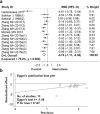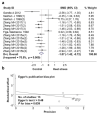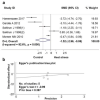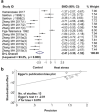The Impact of High Ambient Temperature on Human Sperm Parameters: A Meta-Analysis
- PMID: 35936544
- PMCID: PMC9288403
- DOI: 10.18502/ijph.v51i4.9232
The Impact of High Ambient Temperature on Human Sperm Parameters: A Meta-Analysis
Abstract
Background: Global warming, lifestyle, or working in a high temperature environment leads to have increased health risk factors. This meta-analysis was conducted to determine the impact of high ambient temperature on male reproductive function.
Methods: Scientific articles were screened in the database including MEDLINE, EMBASE, National center for biotechnology information (NCBI) or Web of Science with relating keywords. Impact data of high ambient temperature on semen parameters were extracted and analyzed by STATA software according to the Random Effects Model. The high ambient temperature exposure group and Non-exposure group were compared using the standard mean difference (SMD). Publications were evaluated for publication bias by Egger test.
Results: Nine articles were finally selected from databases examining the effect of high ambient temperature on male reproductive health of 356 men from Iran, Italy, Thailand, China, Egypt. High ambient temperature showed a significant decrease in the seminal parameters, semen volume during each ejaculation (SMD = -0.74; 95% CI -1.11, -0.36), sperm concentration (SMD = -1.07; 95% CI -1.42, -0.72), total sperm count (SMD = -1.52; 95% CI -2.96, -0.08), sperm motility (SMD = -1.93; 95% CI -2.83, -1.04), sperm progressive motility (SMD = -1.65; 95% CI -2.39, -0.91) and normal morphology (SMD = -2.41; 95% CI -3.30, -1.52).
Conclusion: High ambient temperature negatively affects sperm quality, including decreased semen volume, sperm count, sperm concentration, motility and normal morphology. This might lead to protective strategies to avoid the adverse effects of high ambient temperature on male fertility.
Keywords: Global warming; Heat stress; Meta-analysis; Semen; Spermatogenesis; Temperature.
Copyright © 2022 Hoang-Thi et al. Published by Tehran University of Medical Sciences.
Conflict of interest statement
Conflict of interest There is no conflict of interest.
Figures







Similar articles
-
Investigating the association between alcohol intake and male reproductive function: A current meta-analysis.Heliyon. 2023 Apr 24;9(5):e15723. doi: 10.1016/j.heliyon.2023.e15723. eCollection 2023 May. Heliyon. 2023. PMID: 37159717 Free PMC article.
-
Association between ambient temperature and semen quality: A longitudinal study of 10 802 men in China.Environ Int. 2020 Feb;135:105364. doi: 10.1016/j.envint.2019.105364. Epub 2019 Dec 13. Environ Int. 2020. PMID: 31841801
-
Association between exposure to ambient air pollution and semen quality in adults: a meta-analysis.Environ Sci Pollut Res Int. 2022 Feb;29(7):10792-10801. doi: 10.1007/s11356-021-16484-9. Epub 2021 Sep 16. Environ Sci Pollut Res Int. 2022. PMID: 34532803
-
Effects of Metabolic Syndrome on Semen Quality and Circulating Sex Hormones: A Systematic Review and Meta-Analysis.Front Endocrinol (Lausanne). 2020 Aug 11;11:428. doi: 10.3389/fendo.2020.00428. eCollection 2020. Front Endocrinol (Lausanne). 2020. PMID: 32849258 Free PMC article.
-
Association between human papillomavirus infection and sperm quality: A systematic review and a meta-analysis.Andrologia. 2021 Jun;53(5):e14034. doi: 10.1111/and.14034. Epub 2021 Mar 5. Andrologia. 2021. PMID: 33666259
Cited by
-
Recent decline in sperm motility among donor candidates at a sperm bank in Denmark.Hum Reprod. 2024 Aug 1;39(8):1618-1627. doi: 10.1093/humrep/deae115. Hum Reprod. 2024. PMID: 38834185 Free PMC article.
-
Urology on a changing planet: links between climate change and urological disease.Nat Rev Urol. 2025 Apr;22(4):208-222. doi: 10.1038/s41585-024-00979-4. Epub 2025 Jan 28. Nat Rev Urol. 2025. PMID: 39875561 Review.
-
The Spontaneous Abortion of Females is Influenced by Their Male Partner's Heat Wave Exposure During Adolescence: A Nationwide Observational Study in China.Curr Med Sci. 2025 Jun;45(3):594-605. doi: 10.1007/s11596-025-00063-x. Epub 2025 May 21. Curr Med Sci. 2025. PMID: 40397301
-
Effects of Heat Stress on Motion Characteristics and Metabolomic Profiles of Boar Spermatozoa.Genes (Basel). 2022 Sep 14;13(9):1647. doi: 10.3390/genes13091647. Genes (Basel). 2022. PMID: 36140814 Free PMC article.
-
The Impact of Oxidative Stress on Male Reproductive Function: Exploring the Role of Antioxidant Supplementation.Cureus. 2023 Jul 27;15(7):e42583. doi: 10.7759/cureus.42583. eCollection 2023 Jul. Cureus. 2023. PMID: 37641770 Free PMC article. Review.
References
-
- Bongaarts J, Sitruk-Ware R. (2019). Climate change and contraception. BMJ Sexual & Reproductive Health, 45:233–5. - PubMed
-
- Giudice LC. (2021). Environmental impact on reproductive health and risk mitigating strategies. Curr Opin Obstet Gynecol, 33(4):343–349. - PubMed
-
- Hou Y, Wang X, Lei Z, et al. (2015). Heat-stress-induced metabolic changes and altered male reproductive function. J Proteome Res, 14(3):1495–503. - PubMed
Publication types
LinkOut - more resources
Full Text Sources
